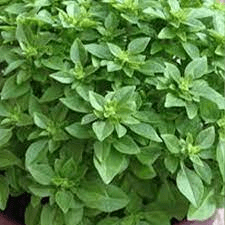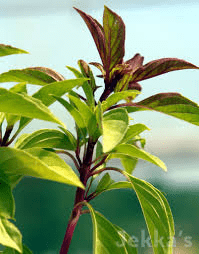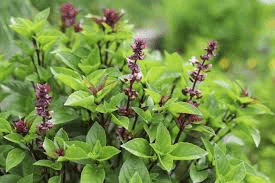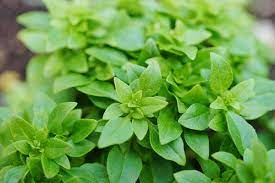Ocimum basilicum var. minimum, commonly known as Dwarf Basil, is a compact and diminutive cultivar of the well-known culinary herb, sweet basil (Ocimum basilicum). This aromatic plant belongs to the Lamiaceae family and is renowned for its culinary and medicinal uses. Here is a brief scientific description of Ocimum basilicum var. minimum:
Dwarf Basil is characterized by its small stature, typically reaching a height of around 6 to 8 inches (15 to 20 cm). The plant forms a dense and bushy habit with numerous small, lance-shaped leaves densely packed along its stems. The leaves are glossy green and emit a distinct sweet and spicy aroma when crushed.
The botanical features of Dwarf Basil include square stems, a characteristic trait of the Lamiaceae family. The plant produces tiny, tubular flowers in shades of white to lavender, arranged in whorls along the stem. These flowers are not only ornamental but also contribute to the plant’s reproductive cycle through seed production.
Similar to its larger counterpart, Dwarf Basil is valued for its culinary applications. The leaves possess a rich flavor profile, combining sweetness and peppery notes, making them an excellent addition to salads, sauces, and various dishes. Medicinally, basil has been traditionally used for its potential anti-inflammatory, antioxidant, and antimicrobial properties.
Dwarf Basil is well-suited for container gardening and small spaces due to its compact size. It thrives in well-drained, fertile soil with ample sunlight. Regular pruning is recommended to maintain the plant’s bushy form and encourage continuous leaf production. Adequate water and protection from extreme weather conditions contribute to successful cultivation.
The essential oils present in Dwarf Basil contribute to its distinctive aroma and flavor. These oils, primarily composed of compounds such as linalool and eugenol, not only enhance the culinary experience but also contribute to the plant’s resistance to certain pests.
In summary, Ocimum basilicum var. minimum, or Dwarf Basil, is a delightful and aromatic herb with compact growth habits, making it a versatile addition to both culinary and ornamental gardens. Its small size, coupled with the characteristic basil fragrance, adds an appealing dimension to diverse uses ranging from cooking to traditional medicine.
The Botanical Description of Ocimum basilicum var. minimum
1. Plant Height: Ocimum basilicum var. minimum, commonly known as dwarf basil, is characterized by its diminutive stature, typically reaching a height of 6 to 12 inches.
2. Leaves: The leaves are small, green, and aromatic, showcasing the classic basil fragrance. They are elliptical in shape with a smooth texture.
3. Stem: Dwarf basil features sturdy, branching stems that support the compact structure of the plant.
4. Flowers: The plant produces delicate, white to lavender flowers, adding a touch of elegance to its appearance.
5. Growth Habit: Exhibiting a bushy growth habit, dwarf basil is well-suited for container gardening and compact spaces.
6. Aroma: The leaves emit a robust and sweet fragrance, reminiscent of traditional basil varieties, making it a popular choice for culinary uses.
7. Leaf Arrangement: The leaves are arranged oppositely along the stems, contributing to the plant’s symmetrical and visually appealing structure.
8. Leaf Edges: The edges of the leaves are smooth, enhancing the overall aesthetic appeal of the plant.
9. Culinary Variability: Despite its small size, dwarf basil maintains the rich flavor profile associated with larger basil varieties, making it a versatile herb in culinary applications.
10. Adaptability: Ocimum basilicum var. minimum is adaptable to various growing conditions, thriving in well-drained soil with ample sunlight.
The Geographic Distribution of Ocimum basilicum var. minimum

1. Native Region: Dwarf basil, believed to be a cultivated variety, is commonly grown in regions with a warm and temperate climate.
2. Global Cultivation: This basil variety is cultivated worldwide, favored by gardeners and culinary enthusiasts for its compact size and aromatic properties.
3. Preferred Climate: Dwarf basil flourishes in climates with temperatures ranging from 50 to 90 degrees Fahrenheit, displaying optimal growth in well-lit areas.
4. Cultivation in Home Gardens: Gardeners often cultivate dwarf basil in pots, gardens, or even on windowsills, allowing easy access for culinary purposes.
5. Regional Variations: While adaptable, regional variations in soil composition and climate may influence the growth characteristics and flavor nuances of dwarf basil.
6. Culinary Gardens: Given its compact nature, dwarf basil is a popular choice for small-scale herb gardens and container gardening, bringing the essence of basil to urban spaces.
7. Greenhouse Cultivation: In colder climates, dwarf basil can be successfully cultivated in greenhouses, extending its growing season and availability.
8. Culinary Diversity: The global popularity of basil in various cuisines contributes to the widespread cultivation of Ocimum basilicum var. minimum in diverse geographic regions.
9. Container Gardening: Its adaptability to container gardening makes dwarf basil a versatile herb for individuals with limited outdoor space.
10. Ornamental Use: Beyond its culinary value, dwarf basil’s aesthetic appeal makes it a sought-after ornamental plant in gardens and landscapes.
The Chemical Composition of Ocimum basilicum var. minimum
1. Essential Oils: Dwarf basil is rich in essential oils, including linalool, eugenol, and cineole, contributing to its distinct aroma and flavor.
2. Polyphenols: The leaves of Ocimum basilicum var. minimum contain polyphenolic compounds with potential antioxidant properties.
3. Flavonoids: Flavonoids, such as orientin and vicenin, are present in dwarf basil, adding to its potential health-promoting benefits.
4. Terpenes: The plant’s chemical composition includes terpenes like beta-caryophyllene, known for its anti-inflammatory properties.
5. Volatile Compounds: Volatile compounds in dwarf basil contribute to its characteristic scent, making it a prized herb in the culinary world.
6. Antimicrobial Agents: Some constituents of dwarf basil exhibit antimicrobial properties, enhancing its traditional use in preserving food and preventing spoilage.
7. Phenolic Acids: Presence of phenolic acids, including rosmarinic acid, adds to the overall antioxidant capacity of dwarf basil.
8. Nutritional Content: Dwarf basil contains essential nutrients, including vitamins A and K, as well as minerals like iron and calcium, contributing to its nutritional value.
9. Eugenol Content: Eugenol, a compound found in dwarf basil, may have anti-inflammatory and analgesic properties.
10. Alkaloids: While present in trace amounts, certain alkaloids contribute to the plant’s overall chemical composition.
11. Beta-Carotene: The leaves of dwarf basil contain beta-carotene, a precursor to vitamin A, providing additional health benefits.
12. Myrcene: Myrcene, a terpene found in dwarf basil, may have relaxing and sedative effects.
13. Limonene: Limonene, another terpene, contributes to the citrusy notes in the aroma of dwarf basil.
14. Ursolic Acid: Dwarf basil contains ursolic acid, a compound with potential anti-inflammatory and anti-cancer properties.
15. Beta-Caryophyllene: Beta-caryophyllene, a terpene present in dwarf basil, may have anti-inflammatory and analgesic effects.
Read Also: 20 Medicinal Health Benefits Of Artemisia herba-alba (White Wormwood)
The Medicinal Health Benefits Of Ocimum basilicum var. minimum (Dwarf basil)

1. Digestive Aid: Dwarf basil is known for its digestive properties, helping alleviate indigestion and bloating.
2. Anti-Inflammatory Effects: Compounds like eugenol and beta-caryophyllene contribute to the anti-inflammatory properties of dwarf basil, potentially benefiting inflammatory conditions.
3. Respiratory Health: The aromatic nature of dwarf basil makes it beneficial for respiratory health, providing relief from conditions like coughs and congestion.
4. Antioxidant Support: The presence of polyphenols and flavonoids imparts antioxidant effects, protecting cells from oxidative stress.
5. Stress Reduction: Aromatherapy with dwarf basil may contribute to stress reduction and relaxation, thanks to its pleasant fragrance.
6. Immune System Boost: The essential oils in dwarf basil, including linalool, may have immunomodulatory effects, supporting the immune system.
7. Antimicrobial Properties: The antimicrobial agents in dwarf basil contribute to its traditional use in food preservation and may have applications in combating certain infections.
8. Skin Health: Applied topically or consumed, dwarf basil may promote skin health due to its antioxidant and anti-inflammatory properties.
9. Blood Sugar Regulation: Some compounds in dwarf basil, such as ursolic acid, may contribute to the regulation of blood sugar levels.
10. Analgesic Effects: The presence of eugenol and beta-caryophyllene provides dwarf basil with analgesic properties, potentially relieving pain.
11. Cardiovascular Support: Compounds like beta-caryophyllene and flavonoids may contribute to cardiovascular health by regulating blood pressure and cholesterol levels.
12. Anti-Anxiety Effects: Aromatherapy with dwarf basil may have mild anti-anxiety effects, promoting relaxation and mental well-being.
13. Anti-Cancer Properties: Preliminary studies suggest that certain compounds
in dwarf basil may exhibit anti-cancer properties, but further research is needed.
14. Cognitive Function: The potential neuroprotective effects of dwarf basil compounds may support cognitive function and brain health.
15. Anti-Aging Properties: Antioxidant compounds in dwarf basil contribute to its potential anti-aging effects by combating oxidative stress.
16. Hormonal Balance: Some compounds in dwarf basil may contribute to hormonal balance, potentially benefiting conditions like menstrual discomfort.
17. Anti-Asthmatic Effects: Traditional uses suggest that dwarf basil may have anti-asthmatic effects, assisting in respiratory conditions.
18. Anti-Allergic Effects: Compounds like rosmarinic acid may contribute to anti-allergic effects, potentially alleviating allergy symptoms.
The Methods of Usage to Achieve the Provided Health Benefits Of Ocimum basilicum var. minimum (Dwarf basil)
1. Culinary Applications: Incorporate dwarf basil into various dishes, including salads, pasta, and soups, to benefit from its digestive and flavorful properties.
2. Herbal Teas: Prepare herbal teas using dried dwarf basil leaves to enjoy respiratory and digestive health benefits.
3. Aromatherapy: Diffuse dwarf basil essential oil in your living space to promote relaxation, alleviate stress, and potentially enhance cognitive function.
4. Topical Applications: Infuse oils with dwarf basil and apply topically for potential skin health benefits, including antioxidant and anti-inflammatory effects.
5. Respiratory Steam: Inhale steam infused with dwarf basil to provide relief from respiratory issues such as congestion and coughs.
6. Tinctures and Extracts: Prepare tinctures or extracts using dwarf basil for a concentrated form that can be added to beverages or used topically.
7. Culinary Garnish: Use fresh dwarf basil leaves as a garnish for dishes to not only enhance flavor but also benefit from its aromatic compounds.
8. Herbal Infusions: Make herbal infusions using dwarf basil by steeping fresh or dried leaves in hot water for a soothing and health-promoting beverage.
9. Culinary Pairings: Pair dwarf basil with other herbs and spices to create flavorful combinations that offer both taste and potential health benefits.
10. Massage Oils: Infuse massage oils with dwarf basil to potentially promote relaxation and ease muscular tension during massages.
11. Inhalers: Create inhalers infused with dwarf basil essential oil for on-the-go aromatherapy to combat stress and promote a sense of well-being.
12. Culinary Oils: Infuse cooking oils with dwarf basil for a unique and health-enhancing addition to your culinary creations.
The Side Effects Of Using Ocimum basilicum var. minimum Medicinal Plant
1. Allergic Reactions: Individuals with known allergies to basil or related plants should exercise caution to avoid potential allergic reactions.
2. Skin Sensitivity: Topical application may cause skin sensitivity or irritation in some individuals. Perform a patch test before extensive use.
3. Gastrointestinal Discomfort: Excessive consumption may lead to gastrointestinal discomfort, including nausea or stomach upset.
4. Photosensitivity: Some individuals may experience photosensitivity when using dwarf basil topically. Take sun protection measures.
5. Drug Interactions: Consult with healthcare professionals, especially if on medications, as certain compounds in dwarf basil may interact with medications.
6. Pregnancy and Lactation: Pregnant and lactating individuals should consult healthcare providers before incorporating dwarf basil into their routine due to limited safety information.
7. Blood Pressure Regulation: Individuals with low blood pressure should monitor their intake, as dwarf basil may have blood pressure-lowering effects.
8. Sedative Effects: Excessive use or inhalation of essential oils may have sedative effects, affecting alertness. Avoid activities requiring full concentration.
9. Respiratory Sensitivity: Individuals with respiratory conditions should be cautious, as inhaling steam or essential oils may trigger respiratory sensitivity.
10. Liver Conditions: Those with liver conditions should exercise caution, as the impact of dwarf basil on liver health is not well-established.
11. Central Nervous System Effects: High doses or prolonged use may affect the central nervous system, leading to drowsiness or mild sedation.
12. Not Suitable for Children: Due to the potency of essential oils, dwarf basil may not be suitable for young children, especially in concentrated forms.
13. Potential Psychotropic Effects: Inhaling or consuming large amounts may have mild psychotropic effects. Exercise caution, especially for individuals sensitive to altered mental states.
14. Respiratory Irritation: Smoking or inhaling preparations may lead to respiratory irritation. This method is not recommended, particularly for individuals with respiratory issues.
Read Also: How to Make Refried Beans
The Scientific Research and Studies of Ocimum basilicum var. minimum

1. Antioxidant Properties: Studies have explored the antioxidant properties of dwarf basil, highlighting its potential in combating oxidative stress.
2. Anti-Inflammatory Effects: Scientific investigations suggest that compounds in dwarf basil may exhibit anti-inflammatory effects, supporting traditional uses.
3. Antimicrobial Activity: Research has identified antimicrobial activity in dwarf basil, showcasing its potential in food preservation and combating certain infections.
4. Gastroprotective Effects: Studies indicate that dwarf basil may have gastroprotective effects, providing potential benefits for digestive health.
5. Respiratory Benefits: Scientific research supports the traditional use of dwarf basil for respiratory conditions, indicating its potential in addressing coughs and congestion.
6. Analgesic Properties: Certain compounds in dwarf basil, such as eugenol, have been studied for their analgesic properties, suggesting potential pain-relieving effects.
7. Immunomodulatory Effects: Research suggests that dwarf basil may have immunomodulatory effects, influencing the immune system’s response.
8. Cardiovascular Health: Preliminary studies indicate potential cardiovascular benefits associated with dwarf basil, including blood pressure regulation.
The Safety Precautions and Recommendations In Using Ocimum basilicum var. minimum Medicinal Plant
1. Allergy Testing: Individuals with allergies to basil or related plants should perform an allergy test before consuming or using dwarf basil extensively.
2. Moderation in Consumption: Consume dwarf basil in moderation to avoid potential gastrointestinal discomfort or other adverse effects.
3. Consultation with Healthcare Professionals: Pregnant, lactating individuals, and those with pre-existing health conditions or on medications should consult healthcare professionals before using dwarf basil.
4. Photosensitivity Awareness: Be aware of potential photosensitivity, especially when using dwarf basil topically. Use sun protection measures if necessary.
5. Monitoring Blood Pressure: Individuals with low blood pressure should monitor their intake, as dwarf basil may have blood pressure-lowering effects.
6. Topical Application Caution: Perform a patch test before extensive topical use to check for skin sensitivity or allergic reactions.
7. Respiratory Sensitivity Consideration: Individuals with respiratory conditions should exercise caution, especially when inhaling steam or essential oils.
8. Liver Health Awareness: Those with liver conditions should be cautious, as the impact of dwarf basil on liver health is not well-established.
9. Central Nervous System Effects: Exercise caution regarding activities requiring full concentration, as high doses may have mild sedative effects.
10. Pregnancy and Lactation: Pregnant and lactating individuals should consult healthcare providers before incorporating dwarf basil into their routine due to limited safety information.
11. Age Consideration: Due to the potency of essential oils, it’s advisable to avoid using concentrated forms of dwarf basil on young children.
12. Dosage Awareness: If using dwarf basil in supplemental forms, such as tinctures or extracts, adhere to recommended dosages to prevent potential adverse effects.
13. Interaction with Medications: Individuals on medications should consult healthcare professionals due to potential interactions between certain compounds in dwarf basil and medications.
14. Monitoring Respiratory Effects: Be mindful of respiratory effects, especially for individuals with respiratory conditions, and discontinue use if adverse reactions occur.
15. Sedative Effects Caution: Avoid activities that require full alertness and concentration if experiencing sedative effects from the use of dwarf basil.
16. Assessing Psychotropic Effects: Exercise caution regarding psychotropic effects, especially for individuals sensitive to altered mental states, and avoid excessive inhalation or consumption.
FAQs About Ocimum basilicum var. minimum Medicinal Plant
1. Is Dwarf Basil Safe for Children?
While culinary use is generally safe, the use of concentrated forms or essential oils may not be suitable for young children due to their potency.
2. Can Dwarf Basil Be Used During Pregnancy?
Pregnant individuals should exercise caution, and consultation with healthcare professionals is advisable due to limited safety information.
3. Are There Any Drug Interactions with Dwarf Basil?
Some compounds in dwarf basil may interact with medications. Consult with healthcare professionals if using medications concurrently.
4. How Can Dwarf Basil Be Used for Respiratory Health?
Inhaling steam infused with dwarf basil or using essential oils in aromatherapy may provide respiratory benefits, helping with congestion and coughs.
5. Is Dwarf Basil Effective for Stress Reduction?
The aromatic nature of dwarf basil makes it a popular choice for aromatherapy, potentially contributing to stress reduction and relaxation.
6. Can Dwarf Basil Be Used Topically for Skin Health?
Topical applications of dwarf basil, such as infused oils, may offer antioxidant and anti-inflammatory effects, promoting skin health.
7. Does Dwarf Basil Have Psychotropic Effects?
In excessive amounts, inhalation or consumption of dwarf basil may have mild psychotropic effects. Caution is advised, especially for those sensitive to altered mental states.
8. What Precautions Should Be Taken for Topical Application?
Perform a patch test before extensive topical use to check for skin sensitivity. Discontinue use if irritation occurs.
9. How Can Dwarf Basil Be Incorporated into Culinary Dishes?
Fresh or dried dwarf basil leaves can be used in various culinary dishes, including salads, pasta, soups, and as a flavorful garnish.
10. Can Dwarf Basil Help with Digestive Issues?
Dwarf basil is known for its digestive properties and can be consumed in culinary dishes or as an herbal tea to aid digestion.
11. Is Dwarf Basil Suitable for Individuals with Allergies?
– Individuals with known allergies to basil or related plants should exercise caution and perform an allergy test before extensive use.
12. Can Dwarf Basil Be Used for Headaches?
Compounds like eugenol in dwarf basil may have analgesic properties, and aromatherapy with its essential oil may offer mild relief for headaches.
13. Is Dwarf Basil Suitable for Individuals with Respiratory Conditions?
Individuals with respiratory conditions should exercise caution, especially when inhaling steam or essential oils, and discontinue use if respiratory sensitivity occurs.
14. Are There Any Known Side Effects of Dwarf Basil?
While generally safe, excessive consumption or use may lead to gastrointestinal discomfort, skin irritation, or other adverse effects. Moderation is advised.
15. How Does Dwarf Basil Contribute to Cardiovascular Health?
Compounds like beta-caryophyllene and flavonoids in dwarf basil may contribute to cardiovascular health by regulating blood pressure and cholesterol levels.
16. Can Dwarf Basil Be Used During Pregnancy?
Pregnant individuals should exercise caution, and consultation with healthcare professionals is advisable due to limited safety information.
Read Also: Tillandsia Care Made Easy: A Comprehensive Guide

